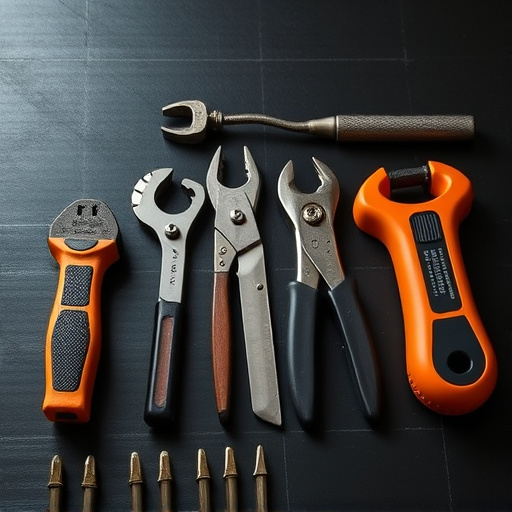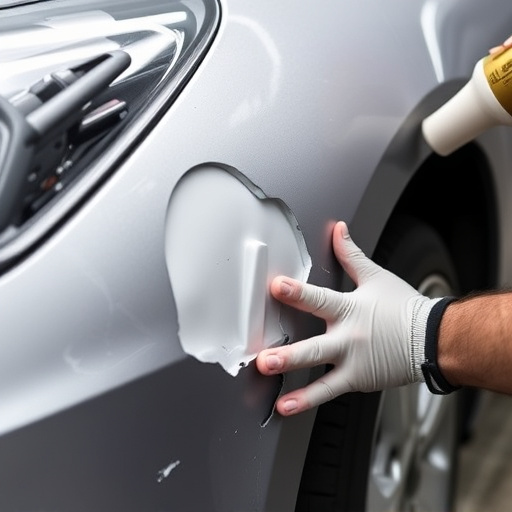Mastering Repair Progress Updates: Minor to Major Strategies

Staying informed is key for vehicle repairs. Regular repair progress updates from fleet services bui…….
In today’s complex and interconnected world, efficient maintenance and repair processes are vital for ensuring operational continuity, safety, and cost-effectiveness across various sectors. At the heart of these efforts lie repair progress updates, a dynamic practice that involves regular communication and reporting on the status, timeline, and outcomes of repair activities. This article aims to provide an in-depth exploration of this critical aspect of maintenance management, offering valuable insights for professionals, researchers, and stakeholders alike. We will delve into its definition, significance, global impact, economic implications, technological innovations, policy frameworks, challenges, case studies, and future prospects, ultimately underscoring the transformative potential of robust repair progress update systems.
Repair progress updates, in its essence, refers to the practice of providing timely, accurate, and comprehensive information about the status and advancement of repair work. It involves several key components:
Real-time Monitoring: This involves utilizing technology and data analytics to track the repair process, including identifying tasks completed, ongoing activities, and potential delays or issues.
Communication Channels: Effective updates require multiple communication channels, such as emails, text messages, dedicated software platforms, or mobile apps, to ensure information reaches all relevant stakeholders promptly.
Documentation: Detailed documentation is essential, encompassing work orders, repair reports, progress notes, and any other relevant records that provide a historical account of the maintenance efforts.
Performance Metrics: Measuring key performance indicators (KPIs) like completion rates, response times, cost efficiency, and customer satisfaction helps assess the effectiveness of the repair process and identifies areas for improvement.
The concept of repair progress updates has evolved over time, driven by advancements in technology and a growing need for transparency and accountability in maintenance operations. Historically:
Early Days: In the past, repair progress was often tracked manually through paper records or basic spreadsheets, making it challenging to maintain accurate and real-time information.
Digital Revolution: The advent of digital technologies, including specialized software solutions and mobile applications, revolutionized repair progress tracking and communication. These tools enabled faster data exchange, improved visibility, and better decision-making.
Industry Standards: Over time, various industries have adopted standardized protocols for repair progress updates, ensuring consistency and facilitating knowledge sharing. This has led to the development of best practices and frameworks that guide maintenance organizations worldwide.
The impact of repair progress updates extends across borders, with many countries adopting and adapting these practices to suit their unique contexts. Key factors driving global influence include:
Standardization: International standards and guidelines, such as those set by ISO (International Organization for Standardization), promote consistent approaches to maintenance management, including repair progress reporting.
Cross-Industry Adoption: Best practices in one industry often resonate across sectors, leading to the widespread adoption of repair progress updates in manufacturing, healthcare, transportation, and infrastructure industries.
Global Supply Chains: In an interconnected global economy, efficient repair and maintenance processes are essential for managing complex supply chains, ensuring product quality, and minimizing disruptions.
While there is a growing trend towards standardization, regional variations exist in the implementation of repair progress updates:
North America and Europe: These regions have generally embraced digital transformation, with advanced software solutions and mobile apps driving efficient repair progress tracking. Robust data analytics and performance metrics are common practices.
Asia Pacific: Rapid industrialization and urbanization in this region have led to a surge in maintenance activities. As a result, there is a growing emphasis on digitalizing repair processes, but adoption varies across countries due to varying economic development levels.
Emerging Markets: Countries in Africa, the Middle East, and Latin America are witnessing increased awareness of the importance of repair progress updates, particularly with foreign investments and the need to meet international standards. However, infrastructure gaps and limited digital literacy pose challenges.
The market for repair and maintenance services is dynamic and diverse, influenced by various factors:
| Factor | Impact |
|---|---|
| Industry Growth: Sectors like manufacturing, energy, and infrastructure experience fluctuations in maintenance demands, directly affecting the need for efficient repair progress tracking. | Drives market demand and innovation in software solutions, consultancies, and training services. |
| Technological Advancements: New technologies, such as IoT (Internet of Things) devices and AI-driven analytics, offer opportunities to optimize maintenance processes, leading to cost savings and improved efficiency. | Encourages investment in digital transformation and advanced repair tools. |
| Regulatory Changes: Government regulations regarding safety, environmental standards, or data privacy can impact maintenance practices, requiring businesses to adapt their repair progress update systems. | Influences compliance-focused software solutions and training programs. |
Implementing robust repair progress update systems offers significant economic advantages:
Cost Savings: Efficient tracking reduces unnecessary repairs, minimizes downtime, and optimizes resource allocation, resulting in substantial cost savings for organizations.
Improved Productivity: Real-time information enables faster decision-making, allowing workers to prioritize tasks and complete repairs more efficiently.
Enhanced Customer Satisfaction: Transparent communication and timely updates contribute to better customer experiences, fostering loyalty and positive word-of-mouth referrals.
Competitive Advantage: Organizations with sophisticated repair progress tracking systems can offer superior service quality, gaining a competitive edge in their industries.
The digital age has brought about significant advancements that have revolutionized repair progress updates:
Cloud-Based Software: Cloud-based platforms offer secure and scalable solutions for managing repair data, enabling remote access and collaboration. This technology ensures data backup, disaster recovery, and seamless information sharing across teams.
Mobile Applications: Dedicated mobile apps provide real-time access to repair progress updates, allowing on-site workers to communicate status, document work, and receive alerts promptly.
Internet of Things (IoT): IoT devices, such as sensors and connected equipment, generate vast amounts of data, enabling predictive maintenance. This technology can anticipate potential failures, reducing unplanned repairs and enhancing efficiency.
Future technologies poised to shape repair progress updates include:
Artificial Intelligence (AI) and Machine Learning: AI algorithms can analyze vast datasets to identify patterns, predict equipment failures, and optimize maintenance schedules, leading to further cost savings and improved uptime.
Augmented Reality (AR) and Virtual Reality (VR): These technologies have the potential to enhance training programs, allowing technicians to practice complex repairs in immersive environments, improving skills and efficiency.
Blockchain: Blockchain technology can ensure data integrity and transparency, providing an immutable record of repair activities, which is particularly useful for audit trails and supply chain management.
Governments worldwide have recognized the importance of efficient maintenance practices and implemented policies to support them:
Safety Regulations: Many countries have strict safety standards for maintenance, especially in critical infrastructure sectors like energy, transportation, and healthcare. These regulations mandate regular reporting on repair activities to ensure compliance.
Environmental Standards: Environmental protection laws often impact maintenance practices, particularly in industries with significant waste generation or emissions. Repair progress updates may need to include information on eco-friendly practices and material disposal.
Data Privacy Laws: With the increasing digitalization of repair data, privacy regulations like GDPR (General Data Protection Regulation) in Europe and CCPA (California Consumer Privacy Act) in the US ensure that personal and sensitive data are handled securely.
Policy implications for repair progress updates include:
Compliance Requirements: Organizations must tailor their update systems to meet regulatory standards, often involving detailed documentation, data retention policies, and transparent reporting practices.
Standardization and Certification: Some industries encourage or mandate the use of specific software solutions or frameworks that adhere to recognized standards, ensuring compatibility and data exchange.
Legal Protection: Effective repair progress tracking can serve as evidence of due diligence in case of legal disputes related to maintenance failures or equipment damage.
Despite its numerous benefits, the implementation of repair progress update systems faces several challenges:
Resistance to Change: Organizations, particularly older, traditional ones, may resist adopting new technologies and processes due to cost concerns, employee resistance, or a lack of understanding.
Data Security and Privacy: As repair data becomes more digital, ensuring the security and privacy of sensitive information is critical, requiring robust cybersecurity measures and adherence to relevant laws.
Initial Implementation Costs: Upfront investment in specialized software, hardware, and training can be significant, especially for smaller organizations with limited budgets.
Proactive approaches to address these challenges include:
Change Management: Organizations should develop comprehensive change management plans, highlighting the benefits of digital transformation, providing adequate training, and fostering a culture that embraces innovation.
Cybersecurity Measures: Implementing strong data encryption, access controls, and regular security audits can mitigate risks associated with digital repair data storage and transmission.
Financial Planning and Partnerships: Governments and maintenance organizations can collaborate to offer incentives, grants, or subsidized financing for adopting advanced repair progress tracking systems, making them more accessible.
A major energy utility company implemented a digitalized repair progress update system to manage the maintenance of its smart grid infrastructure. The project involved:
A large international airport embarked on a digital transformation journey to optimize its maintenance operations. Their strategy included:
A shipping company implemented an IoT-driven repair progress update system to enhance its maintenance practices, focusing on sustainability:
The future of repair progress updates is promising, with several trends shaping its trajectory:
AI and Automation: Advanced AI applications will continue to revolutionize predictive maintenance, automated scheduling, and remote troubleshooting, leading to increased efficiency.
Digital Twin Technology: Creating digital replicas of physical assets enables realistic simulations, allowing technicians to practice complex repairs in a virtual environment before performing them on real equipment.
Blockchain Integration: Beyond data integrity, blockchain has the potential to facilitate secure data sharing between organizations, enhance transparency, and streamline supply chain management processes.
To stay ahead of the curve, organizations should:
Invest in Digital Skills: Building a digitally literate workforce is essential for adopting new technologies effectively and ensuring smooth transition processes.
Collaborate and Share Best Practices: Industry partnerships and knowledge-sharing platforms can accelerate innovation, foster collaboration, and drive adoption of best practices in repair progress tracking.
Embrace Sustainability: Incorporating sustainable practices into maintenance strategies will be crucial, with a focus on energy-efficient technologies, waste reduction, and eco-friendly material choices.
The concept of repair progress updates has evolved from a basic practice to a critical component of modern maintenance management. As organizations navigate an increasingly complex and interconnected world, efficient tracking and communication of repair activities become indispensable for operational excellence, cost optimization, and safety. This article has provided a comprehensive overview of repair progress updates, highlighting their historical context, global impact, economic implications, technological advancements, policy frameworks, challenges, and future prospects.
By embracing digital transformation, adopting advanced technologies, and prioritizing data-driven decision-making, maintenance organizations can elevate their repair progress update systems to new heights. The case studies presented illustrate the tangible benefits that can be achieved through strategic investments in this area, ultimately contributing to improved performance, enhanced customer satisfaction, and a more sustainable future.
Q: Why is repair progress tracking important for maintenance organizations?
A: Repair progress tracking ensures transparency, accountability, and efficient resource allocation. It allows organizations to monitor the status of repairs, identify bottlenecks, and make data-driven decisions to optimize their operations.
Q: How does digital transformation benefit repair progress updates?
A: Digital transformation enables real-time monitoring, automated reporting, and seamless communication through cloud-based platforms and mobile apps. It also facilitates advanced analytics, predictive maintenance, and improved data security.
Q: What are the key challenges in implementing a new repair progress update system?
A: Common challenges include resistance to change, initial implementation costs, and ensuring data security and privacy. Change management, financial planning, and robust cybersecurity measures can help overcome these hurdles.
Q: How does AI enhance repair progress updates?
A: AI algorithms enable predictive maintenance by analyzing vast datasets, allowing organizations to anticipate equipment failures. AI also automates reporting, provides insights for decision-making, and supports remote troubleshooting.
Q: What are the environmental benefits of efficient repair progress tracking?
A: Efficient maintenance reduces unplanned repairs, minimizing downtime and fuel consumption. It leads to lower carbon emissions and contributes to sustainability goals by optimizing resource usage.

Staying informed is key for vehicle repairs. Regular repair progress updates from fleet services bui…….

Acknowledge and address customer anxieties about intricate repairs like Mercedes-Benz collision repa…….

Repair progress updates are vital in auto repair, especially for classic car restoration, building t…….

Regular repair progress updates via email or text build trust and enhance customer satisfaction in a…….

Regular repair progress updates for electric and hybrid vehicles enhance transparency, empower custo…….

In the digital era, repair progress updates revolutionize auto repair services. These real-time tool…….

Regular repair progress updates are essential for car owners to stay informed and build trust with m…….

Staying informed about EV/hybrid repairs is vital for car owners, ensuring transparency and efficien…….